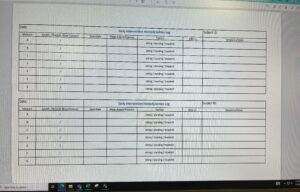Hi all! This is week four of my internship at the Fraizer Rehab Facility in Louisville Kentucky. Even though this week was short due to the holiday, it was still a fantastic week! I continued to observe physical and occupation therapy sessions. Now that I have been here for an extended amount of time, I have been given more responsibilities, which makes the experience so much more fun and engaging. This week I received a lesson on how to operate the transcutaneous stimulation machine, I described this method of stimulation in my week two blog. This machine is about the size of a rectangular tissue box and has a small computer screen filled with numbers arranged in columns according to channels. You can set each different channel to the frequency needed. While the stimulus is turned on and is running, the computer screen needs to be watched very closely. One of the numbers indicates how well the stimulation pads are stuck onto the skin of the patient. If the number gets really high, around 0.8, this is an indication that the pads have somehow come off of the patient, that only one end of the pad is stuck to the skin still. This scenario can be very bad since the stimulus is still sending the same amount of frequency through that pad, just on one small area of the skin. This can lead to a burn on the skin, or irritation of the skin.
Most patients do not use transcutaneous stimulation in the clinic, it is more of a research only based stimulation. This is due to the fact that different patients respond differently to this type of stimulation depending on the level of injury. It is also very important to know where to place the stimulation pads and to what degree of electricity should be administered through those pads. These factors can only be found by doing previous research on the specific patient.
I also was given the task of completing a spreadsheet to measure blood pressure of patients while in physical therapy. I needed to include a column for the systolic and diastolic blood pressure, heart rate and mean arterial pressure. The position of the patient and whether stimulation was on or off in that instance were very critical components as well. The Pinhead assignment of making an excel worksheet that we had to do prior to starting our internships came in very useful in this instance.
The reason for taking the blood pressure is another research project, which aims to figure out if having a spinal cord injury affects blood pressure and to what degree, specifically in kids. That is one of the things that most people don’t realize about spinal cord injuries. Having an SCI not only affects your ability to move it also affects your internal body functions. This week I learned more about the “side effects” of a SCI. A specific one is autonomic dysreflexia. To understand this completely you first need to know the systems that make up the autonomic system in the body. There is the sympathetic nervous system (SNS), which activates body processes that help you in times of need, times when you feel stressed or in danger, this is your fight or flight response. Almost all of these SNS nerves are found underneath the T1 level. Then there is the parasympathetic nervous system (PNS), this system is the exact opposite of the SNS, it is responsible for the rest and digest processes in the body, most of these nerves are found above the T1 level. So basically, SNS on the bottom and PNS on the top. So now that we know some background, autonomic dysreflexia occurs in SCI patients who have been injured above the T6 level. When there is an unpleasant stimulus below the level of injury (this could be a full bladder, wounds, broken bones etc.) the SNS is provoked and starts to think the body is in danger or under stressful circumstances. This system raises the blood pressure by constricting the blood vessels. In an uninjured person this would be totally fine since this constriction will get corrected by the PNS, which stimulates dilation, to lower blood pressure. But in SCI patients, the connection between the SNS and the PNS has been cut off. The PNS still responds, but it cannot correct the constriction in the blood vessels from the SNS, because that pathway is broken, they can’t communicate anymore.
Some major symptoms that occur from AD are sweating, blurred vision, headache, goosebumps and splotchy skin. It is super important to recognize the symptoms of AD since this is a medical emergency because of the sky rocketing blood pressure.
That is the majority of what I learned and accomplished this week!
On Friday, my aunt, cousin and sister flew into Louisville and came to visit for the weekend. We spent our time shopping, getting our nails done, and touring the Churchill Downs museum. I had an amazing weekend and it was so great to see my family!
I am very excited to see what this coming week has in store for me!




There are no comments published yet.